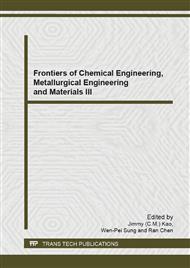[1]
R. Vandermeer, The recrystallization characteristics of moderately deformed aluminum, Metallurgical Transactions, 1 (1970) 819-826.
DOI: 10.1007/bf02811760
Google Scholar
[2]
S. Chen, D. Hanlon, S. Van Der Zwaag, Y. Pei, J.T.M. Dehosson, Quantification of the recrystallization behaviour in Al-alloy AA1050, J. Mater. Sci., 37 (2002) 989-995.
DOI: 10.1023/a:1014356116058
Google Scholar
[3]
Tarasiuk, P. Gerber, B. Bacroix, Estimation of recrystallized volume fraction from EBSD data, Acta Materialia, 50 (2002) 1467-1477.
DOI: 10.1016/s1359-6454(02)00005-8
Google Scholar
[4]
MAUD, Material Analysis Using Diffraction on http: /www. ing. unitn. it.
Google Scholar
[5]
L. Lutterotti, MAUD, in: CPD NEWSLETTER, (IUCr), (2000).
Google Scholar
[6]
F.J. Humphreys, M. Hatherly, Recrystallization and Related Annealing Phenomena, Seconded., Elsevier Pergamon Press, Oxford, (2004).
Google Scholar
[7]
S. Jakani, Effet des impuretés sur les mécanismes de recristallisation du cuivre tréfilé, Ph. D thesis, Université de Paris XI, Orsay, France, (2004).
Google Scholar
[8]
H.E. Kissinger, Reaction Kinetics in Differential Thermal Analysis, Analytical Chemistry, 29(1957) 1702-1706.
DOI: 10.1021/ac60131a045
Google Scholar
[9]
P.G. Boswell, On the calculation of activation energies using a modified Kissinger method, Journal of Thermal Analysis, 18 (1980) 353- 358.
DOI: 10.1007/bf02055820
Google Scholar
[10]
T. Ozawa, Estimation of activation energy by isoconversion methods, Thermochimica Acta, 203 (1992) 159-165.
DOI: 10.1016/0040-6031(92)85192-x
Google Scholar
[11]
M. Starink, Analysis of aluminum based alloys by calorimetry: quantitative analysis of reactions and reaction kinetics, International Materials Reviews, 49 (2004) 191-226.
DOI: 10.1179/095066004225010532
Google Scholar
[12]
E.J. Mittemeijer, Analysis of the kinetics of phase transformations, J. Mater. Sci., 27 (1992) 3977-3987.
Google Scholar
[13]
K. Matusita, T. Komatsu, R. Yokota, Kinetics of non-isothermal crystallization process and activation energy for crystal growth in amorphous materials, J. Mater. Sci., 19 (1984) 291-296.
DOI: 10.1007/bf02403137
Google Scholar
[14]
N. Hua, W. Chen, X. Liu, F. Yue, Isochronal and isothermal crystallization kinetics of Zr–Al–Fe glassy alloys: Effect of high–Zr content, Journal of Non-Crystalline Solids, 388 (2014) 10-16.
DOI: 10.1016/j.jnoncrysol.2014.01.013
Google Scholar


